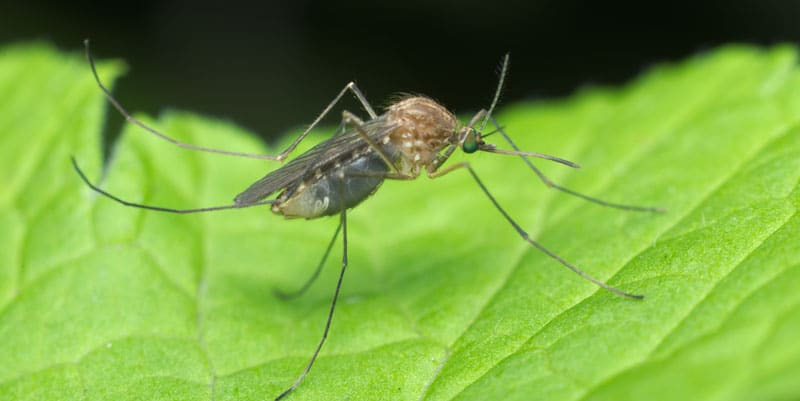
Mosquitoes Transmit Diseases in Illinois
The most immediate danger from mosquitoes in central Illinois is West Nile virus. It’s not just an inconvenience, it can be debilitating or fatal.
West Nile virus (WNV) was first discovered in the United States in New York City during 1999. It has since spread south and west with confirmation in Central Illinois during 2001. In 2002, an epidemic of WNV in Illinois resulted in 884 human cases of the disease with 66 deaths. WNV is caused by a virus that cycle between mosquitoes and birds, with occasional spill-over into humans and other mammals. The virus can have a high mortality in certain bird species while having little effect on other bird species. Crows and Blue Jays are extremely susceptible to the virus, as are eagles, hawks, and other raptors. Humans are considered a dead-end host for the virus, which cannot be transmitted from person to person.
Mosquitoes from the genus Culex, in particular the species Culex pipiens, are the vector of WNV from birds to birds and birds to humans. These mosquitoes deposit their eggs in raft clusters of 50-400 eggs directly on the water’s surface. They are most abundant in periods lacking rainfall, when areas of stagnant water prevail. They are well adapted to many habitats including curbside storm water catch basins, off-road storm water catch basins, discarded tires, buckets & other artificial containers, rain gutters, bird baths, unused swimming pools, ditches, ponds, etc. Anywhere that water can stand for more than a week can become a potential breeding source for Culex mosquitoes. The adult mosquito is a non-aggressive biter with feeding primarily confined to evening or night hours. The adult mosquito seldom travels more than 1/2 mile from its source. The Culex mosquitoes can have many over-lapping generations each season, and over-winter as adults.
The surveillance and control of Culex mosquitoes is very crucial in the efforts to reduce as much as possible the occurrence of WNV.
Reporting and testing of dead birds is one way to check for the presence of West Nile virus in the environment. For more information and/or to inquire about the testing of dead birds for West Nile virus, please call the Macon County Health Department 217-423-6988 ext: 1134.
Signs & Symptoms
If you are bitten by a mosquito, you probably don’t need to see a doctor. Most people who are infected with West Nile virus will not have any symptoms and some will develop a mild flu-like illness. However, the virus can also cause encephalitis or meningitis which can be serious health threats. Symptoms generally appear three to fifteen days after exposure.
Serious symptoms in a few people: About 1 in 150 people infected with WNV will develop severe illness. This may include high fever, headache, neck stiffness, stupor, disorientation, coma, tremors, convulsions, muscle weakness, vision loss, numbness and paralysis. These symptoms may last several weeks and neurological effects may be permanent.
Milder symptoms in some people: Up to 20% of people infected with WNV develop West Nile fever, symptoms of which may include fever, headache, body aches, nausea, vomiting, and sometimes swollen lymph glands or a skin rash on the chest, stomach and back. Symptoms may last a few days to several weeks.
No symptoms in most people: Approximately 80% of people who are infected with WNV will not show any symptoms at all.
Who is at Risk?
While everyone is equally susceptible to WNV, people over the age of 50 are at greatest risk for contracting more severe forms of the disease. No vaccine for people exists at this time and only supportive treatment is available for symptomatic cases.
Other Mosquito related viruses and diseases
St. Louis Encephalitis (SLE)
As with West Nile virus (WNV), SLE is caused by a virus that cycles between mosquitoes and birds, with occasional spill-over into humans and other mammals. Humans are considered a dead-end host for the virus, which cannot be transmitted from person to person. Unlike WNV, the virus has little effect on birds that are infected. SLE affects the central nervous system causing an inflammation of the brain. Most human infections are subclinical (mild and not diagnosed) exhibiting flu-like symptoms. More severe cases can exhibit high fever, nausea, headache, personality changes, paralysis, and in 2-20% of the severe cases, death. The elderly are most susceptible to SLE. An epidemic of SLE within Illinois occurred in 1975, with a few cases reported in the 1980’s and 1990’s. The mosquitoes that transmit (vector) SLE are the same as WNV, with description under that
category.
Other Encephalitis Viruses
LaCrosse Encephalitis (LAC) is caused by a virus that cycles between mosquitoes and small mammals as chipmunks and ground squirrels. Humans are considered a dead-end host. LAC is endemic in Illinois with 5-15 cases per year, primarily occurring in local foci in central and northwestern regions of the state. The majority of LAC cases are mild and subclinical. Less than 1% fatality occurs in cases severe enough to be diagnosed. Children under the age of 16 are most susceptible to this virus. As with other mosquito-borne encephalitis, LAC cannot be transmitted from person to person. The eastern tree hole mosquito, Ochlerotatus triseriatus (formerly Aedes triseriatus) is the vector of this disease. This mosquito normally develops in water filled rot cavities in trees (tree holes), but has adapted well to many man-made habitats as discarded tires, buckets, and other artificial containers. The Ochlerotatus triseriatus adult mosquito lays its eggs singly on the inside wall of the tree hole or artificial container just above the waterline. The adult mosquito is an aggressive biter with feeding all day long, and generally stays within the vicinity of its source. The Ochlerotatus triseriatus has one generation each season, and over-winters in the egg stage.
Western Equine Encephalitis (WEE) is similar to SLE, cycling between birds and mosquitoes with rare spill-over to the human population. WEE primarily affects horses, and is typically found west of the Mississippi River, but has also been found in Illinois. Human cases severe enough to be diagnosed can have a 2-5% fatality. The primary vector of WEE is Culex tarsalis, and possibly Culex pipiens. The Culex tarsalis, like other Culex, lay eggs in rafts directly on the water’s surface. The mosquito can be found in sunlit sources with high organic content as ditches and artificial containers. The mosquito seldom travels more than 1 mile from its source,
however has been known to travel up to 10 miles. This species has continuous generations each season, and over-winters as adults.
Eastern Equine Encephalitis (EEE) is another virus that cycles between birds and mosquitoes with horses and humans as dead-end hosts. Human infections of EEE can range from mild to severe, with 50-75% of diagnosed severe cases resulting in death. Fortunately, human cases of EEE are rare with only 150 cases throughout the United States from 1964-1998. No human cases of EEE have been reported in Illinois, although the virus has been found regularly in bird populations. The primary vector of EEE is Coquillettidia perturbans, a mosquito found in wetlands. They lay their eggs in rafts directly on the water’s surface. The mosquito is an aggressive biter, strong flier, and feeds during the evening or night. This species usually has one generation each season, and over-winters as larvae attached to the stems of cattails or similar aquatic plants.
Other Mosquito-Borne Diseases
Malaria is a disease caused by a protozoan parasite transmitted from person to person via the mosquito. At one time, malaria was prevalent in Illinois, with concentration in the southern part of the state. Mosquito control efforts in the 1920’s have eliminated the risk of malaria in Illinois, although the mosquito which carries the disease, Anopheles quadrimaculatus, is still found in the area.
Dengue and Yellow Fever are both diseases caused by viruses that are transmitted by mosquitoes. They are common in the Caribbean, South America, Asia, and Africa, but are unlikely to occur in Illinois.
Canine (Dog) Heartworm is a disease affecting dogs that is transmitted by mosquitoes. It is caused by a roundworm, Dirofilaria imitus. The Culex pipiens and possibly Aedes vexans are the vectors in our area. The disease is ongoing and best controlled by prevention. Veterinarians typically prescribe drugs to prevent the roundworm larvae development in dogs.
HIV in Mosquitoes
Mosquito-borne viruses must be able to multiply and infect the salivary glands of the mosquito. This does not occur when HIV is ingested by mosquitoes. Studies have concluded that mosquitoes are not a factor in HIV transmission.
Check out the following links for more West Nile virus information:
West Nile Virus Info from Centers for Disease Control & Prevention
West Nile Virus Info from Illinois Department of Public Health
West Nile Virus FAQ from Illinois Department of Public Health
West Nile Virus Info from Macon County Public Health Department






